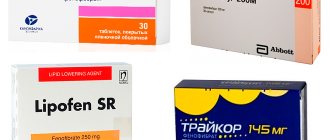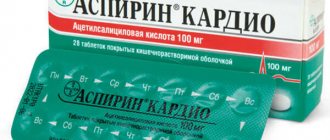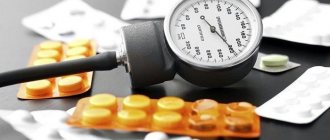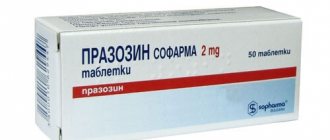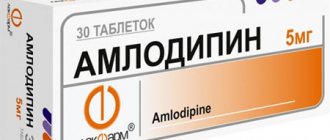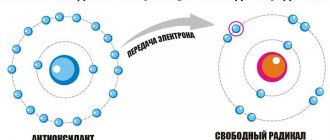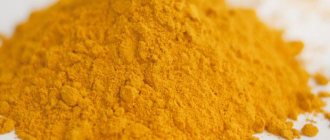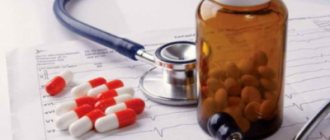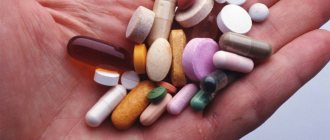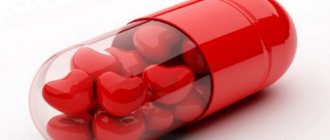Various vascular diseases lead to the formation of blood clots. This leads to very dangerous consequences, since, for example, a heart attack or stroke can occur. To thin the blood, your doctor may prescribe medications that help reduce blood clotting. They are called anticoagulants and are used to prevent blood clots from forming in the body.
They help block fibrin formation. Most often they are used in situations where blood clotting is increased in the body.
It can arise due to problems such as:
- Varicose veins or phlebitis;
- Thrombi of the inferior vena cava;
- Blood clots of hemorrhoidal veins;
- Stroke;
- Myocardial infarction;
- Arterial injuries in the presence of atherosclerosis;
- Thromboembolism;
- Shock, trauma or sepsis can also lead to blood clots.
Anticoagulants are used to improve blood clotting. If earlier they used Aspirin, now doctors have abandoned this technique, because there are much more effective drugs.
Direct and indirect anticoagulants
There are direct and indirect anticoagulants. The former quickly thin the blood and are eliminated from the body within a few hours. The latter accumulate gradually, providing a therapeutic effect in a prolonged form.
Since these drugs reduce blood clotting, you cannot lower or increase the dosage on your own, or shorten the time of administration. Medicines are used according to the regimen prescribed by the doctor.
Direct anticoagulants
Direct anticoagulants reduce thrombin synthesis. In addition, they inhibit the formation of fibrin. Anticoagulants are aimed at the liver and inhibit the formation of blood clotting.
Direct anticoagulants are well known to everyone. These are heparins for local action and for subcutaneous or intravenous administration. In another article you will find even more information about ointments with heparin.
For example, local action:
- Heparin ointment;
- Lyoton gel;
- Hepatrombin;
- Trombless. See reviews of Trombless gel here.
These drugs are used for thrombosis of the veins of the lower extremities for the treatment and prevention of the disease.
They have a higher penetration rate, but are less effective than intravenous agents.
Heparins for administration:
- Fraxiparine;
- Clexane;
- Fragmin;
- Klivarin.
Typically, anticoagulants are selected to solve specific problems. For example, Klivarin and Troparin are used to prevent embolism and thrombosis. Clexane and Fragmin - for angina pectoris, heart attack, vein thrombosis and other problems.
Fragmin is used for hemodialysis. Anticoagulants are used when there is a risk of blood clots in any vessels, both arteries and veins. The activity of the drug lasts the whole day.
Indirect anticoagulants
Indirect anticoagulants are so named because they affect the creation of prothrombin in the liver, and do not directly affect coagulation itself. This process is long, but the effect is prolonged.
They are divided into 3 groups:
- Monocoumarins. These include: Warfarin, Sinkumar, Gloomar;
- Dicoumarins are Dicoumarin and Tromexane;
- Indandiones are Phenilin, Omefin, Dipaxin.
Most often, doctors prescribe Warfarin. These drugs are prescribed in two cases: for atrial fibrillation and artificial heart valves.
Patients often ask what is the difference between Cardio Aspirin and Warfarin, and is it possible to replace one drug with another?
Experts answer that Aspirin Cardio is prescribed if the risk of stroke is not high.
Warfarin is much more effective than Aspirin, and it is better to take it for several months, or even throughout your life.
Aspirin corrodes the stomach lining and is more toxic to the liver.
Indirect anticoagulants reduce the production of substances that affect coagulation, they also reduce the production of prothrombin in the liver and are vitamin K antagonists.
Indirect anticoagulants include vitamin K antagonists:
- Sinkumar;
- Warfarex;
- Fenilin.
Vitamin K is involved in the process of blood clotting, and under the influence of Warfarin its functions are impaired. It helps prevent blood clots from breaking off and blocking blood vessels. This drug is often prescribed after a myocardial infarction.
There are direct and selective thrombin inhibitors:
Direct:
- Angiox and Pradaxa;
Selective:
- Eliquis and Xarelto.
Any anticoagulants of direct and indirect action are prescribed only by a doctor, otherwise there is a high risk of bleeding. Indirect anticoagulants accumulate in the body gradually.
They are used only orally. It is impossible to stop treatment immediately; it is necessary to gradually reduce the dose of the drug. Abrupt withdrawal of the drug can cause thrombosis. An overdose of this group may cause bleeding.
How to determine the effectiveness of taking anticoagulants?
Indirect coagulants are easy to detect in the blood and even measure their effectiveness. For this purpose, a special indicator called “international normalized ratio” has been developed.
- A person not taking indirect anticoagulants will have an INR just below 1.
- A patient taking warfarin will have an INR between 2.0 and 3.0. Seeing such high numbers, doctors will be prepared for the possibility of sudden bleeding.
- An INR between 1 and 2 will indicate that the patient may be at risk of developing an ischemic stroke.
- With an INR of 4 or higher, there is the greatest risk of blood non-coagulation and the development of hemorrhagic stroke.
But a blood test for INR will not provide objective indicators if the patient is taking direct anticoagulants. The biggest problem with the newer direct anticoagulants is the lack of a reliable way to assess their effectiveness. Doctors can tell when bleeding stops, but there is no indicator that assesses the presence of anticoagulant effects. For example, this is very important when treating patients who are admitted to the emergency room in an unconscious state. If the medical record does not indicate any information about the patient taking direct-acting anticoagulants, it is quite difficult to quickly detect them in the blood.
Use of anticoagulants
Clinical use of anticoagulants is recommended for the following diseases:
- Pulmonary and myocardial infarction;
- Embolic and thrombotic stroke (except hemorrhagic);
- Phlebothrombosis and thrombophlebitis;
- Embolism of blood vessels of various internal organs.
Can be used as a preventive measure for:
- Atherosclerosis of coronary arteries, cerebral vessels and peripheral arteries;
- Heart defects rheumatic mitral;
- Phlebothrombosis;
- Postoperative period to prevent blood clots.
conclusions
Since the mid-twentieth century, new substances have been used in practical medicine that can reduce the ability of blood to form a clot.
It all started when in one settlement cows began to die from an unknown disease, in which any injury to the cattle led to its death due to bleeding that did not stop.
Scientists later found out that they were using a substance called dicumarol. Since then, the era of anticoagulants began. During which millions of people were saved.
Currently, the development of more universal products that have a minimum number of side effects and have maximum effectiveness continues.
Natural anticoagulants
Thanks to the process of blood clotting, the body itself ensures that the clot does not extend beyond the affected vessel. One milliliter of blood can help clot all fibrinogen in the body.
Due to its movement, blood maintains a liquid state, as well as due to natural coagulants. Natural coagulants are produced in tissues and then enter the bloodstream, where they prevent the activation of blood clotting.
These anticoagulants include:
- Heparin;
- Antithrombin III;
- Alpha-2 macroglobulin.
Pros and cons of new generation drugs
NOAs (new oral anticoagulants) have a number of advantages over their predecessors. Depending on the drug and its group, the following positive innovations exist:
- reduced likelihood of intracranial and fatal bleeding;
- the incidence of embolism is not higher in predecessors, and sometimes lower;
- the possibility of relatively safe use of NOA if Warfarin is prohibited;
- rapid onset and cessation of action (about two hours);
- reversible inhibition of free thrombin-binding factor and thrombin itself;
- lack of interaction with oteocalcin and GLA protein;
- low influence of food and other drugs used;
- short half-life (about 5-16 hours).
However, there are a number of disadvantages of modern anticoagulants, such as:
- The need to regularly take certain NOAs. Some older anticoagulants allowed you to skip several doses because they had a long-term effect, which did not entail a sharp change in blood counts.
- Lack of validated tests for emergency cessation of anticoagulant therapy or for monitoring adherence to therapy.
- Availability of a large number of tests for each of the new anticoagulants.
- Intolerance to some new drugs in patients who took similar older generation anticoagulants without side effects.
- There may be an increased risk of gastrointestinal bleeding.
- High price.
Innovative cream for the prevention and treatment of varicose veins Varicobooster - you need to know this. How to use medical Varifort most effectively and safely. Tips and instructions, reviews and analysis, and much more in our material.
Anticoagulant drugs - list
Direct-acting anticoagulants are absorbed quickly and their duration of action is no more than a day before repeated administration or application.
Indirect anticoagulants accumulate in the blood, creating a cumulative effect.
They should not be canceled immediately, as this may promote thrombosis. When taking them, the dosage is gradually reduced.
Direct local anticoagulants:
- Heparin ointment;
- Lyoton gel;
- Hepatrombin;
- Trombless
Anticoagulants for intravenous or intradermal administration:
- Fraxiparine;
- Clexane;
- Fragmin;
- Klivarin.
Indirect anticoagulants:
- Hirugen;
- Gyrulog;
- Argatroban;
- Warfarin Nycomed tablet;
- Phenilin in tablet.
Reviews
Marina, 29 years old I have had blood clotting disorders since childhood. I didn’t know anything particularly about anticoagulants as a pharmacological group. The doctor advised me to take an Aspirin tablet every morning. So I have been continuing this procedure for several years. Since there are no health problems, I think this medicine works. Cheap and cheerful.
Alexandra, 37 years old From the list I chose the medical drug Rivaroxaban. The medicine is new, but effective - it provides effective prevention of thrombosis. In our family, this disease is inherited through the female line, so I worried in advance about publicly available preventive measures. The drug is inexpensive, no complaints.
Victoria, 32 years old I have been diagnosed with varicose veins for several years now. The veins have not only become the cause of a strong inferiority complex, but also periodically hurt. The medical drug Lyoton gel from the list of direct anticoagulants helped me. The medicine works quickly and additionally relieves increased fatigue of the limbs after a working day.
Valentina, 41 years old From the list of drugs, I can praise Warfarin, which acts quickly and accurately on a health problem. A year ago, a doctor diagnosed me with a microstroke, and it was completely unexpected for me - apparently, I suffered it on my feet. This medicine was immediately prescribed for quick rehabilitation. The drug helped, no side effects occurred, although they were threatened.
After 50 years, blood vessels become less elastic and there is a risk of blood clots.
To avoid the risk of excessive blood clots, doctors prescribe anticoagulants. Anticoagulants are also prescribed to treat varicose veins. Anticoagulants are a group of drugs that affect the formation of blood clots. They prevent the process of platelet coagulation by influencing the main stages of the functional activity of blood clots, thereby blocking platelet coagulation.
In order to reduce the number of tragic outcomes of diseases of the cardiovascular system, doctors prescribe anticoagulants.
The main mechanism of action of anticoagulants is to prevent the formation and expansion of blood clots that can block an artery vessel, thereby reducing the risk of stroke and myocardial infarction.
Contraindications
There are quite a few contraindications to the use of anticoagulants, so be sure to check with your doctor about the advisability of taking the drugs.
Cannot be used for:
- ICD;
- Peptic ulcer;
- Parenchymal diseases of the liver and kidneys;
- Septic endocarditis;
- Increased vascular permeability;
- With high blood pressure due to myocardial infarction;
- Oncological diseases;
- Leukemia;
- Acute cardiac aneurysm;
- Allergic diseases;
- Hemorrhagic diathesis;
- Fibroids;
- Pregnancy.
Use caution during menstruation in women. Not recommended for nursing mothers.
Antiplatelet agents
These are substances that can reduce the aggregation of platelets involved in thrombus formation. They are often used in conjunction with other drugs, enhancing and complementing their effect. A prominent representative of the antiplatelet agent is acetylsalicylic acid (aspirin).
This group also includes anti-gout and vasodilator drugs, antispasmodics, and the blood substitute reopolyglucin.
Main drugs:
- Aspirin. Leads to disruption of arachidonic acid metabolism.
- Ticlopidine. The drug is able to cleave PIF2 (phosphatidylinositol-4, 5-diphosphate) and change platelet aggregation.
- Clopidogrel (thienopyridine). The structure is similar to ticlopidine, but the drug itself is less toxic.
- Tirofiban. Low molecular weight inhibitor of glycoprotein IIb/IIIa. Has a short duration of action.
- Dipyridamole. Vasodilator.
- Abciximab. Consists of Fab fragments of monoclonal antibodies to glycoprotein IIb/IIIa. Has the property of binding to avβ3-integrin.
- Eptifibatite. Cyclic peptide, disrupts platelet aggregation.
